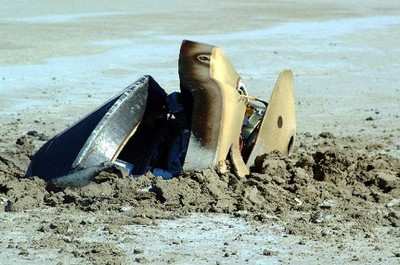Sun, Sep 19, 2004
But It's Looking Good...
Genesis team scientists and engineers continue their work on the
mission's sample return canister in a specially constructed clean
room at the US Army Proving Ground in Dugway (UT). As more of the
capsule's contents are revealed, the team's level of enthusiasm for
the amount of science obtainable continues to rise.

Right now, the science canister that holds the majority of the
mission's scientific samples is lying upside down - on its lid.
Scientists are very methodically working their way "up" from the
bottom portion of the canister by trimming away small portions of
the canister's wall. The team continues to extract, from the
interior of the science canister, small but potentially analyzable
fragments of collector array material. One-half of a sapphire wafer
was collected Tuesday - the biggest piece of collector array to
date.
The mission's main priority is to measure oxygen isotopes to
determine which of several theories is correct regarding the role
of oxygen in the formation of the solar system. Scientists hope to
determine this with isotopes collected in the four target segments
of the solar wind concentrator carried by the Genesis spacecraft.
The condition of these segments will be better known over the next
few days, after the canister's solar wind concentrator is
extricated. At this time, it is believed that three of these
segments are relatively intact and that the fourth may have
sustained one or more fractures.

There are no concrete plans regarding the shipping date of the
Genesis capsule or its contents from Dugway to the Johnson Space
Center in Houston. The team continues its meticulous work and
believes that a significant repository of solar wind materials may
have survived that will keep the science community busy for some
time.
The Genesis sample return capsule landed well within the
projected ellipse path in the Utah Test and Training Range on Sept.
8, but its parachutes did not open. It impacted the ground at
nearly 320 kilometers per hour (nearly 200 miles per hour).
More News
Aero Linx: JAARS Nearly 1.5 billion people, using more than 5,500 languages, do not have a full Bible in their first language. Many of these people live in the most remote parts of>[...]
'Airplane Bounced Twice On The Grass Runway, Resulting In The Nose Wheel Separating From The Airplane...' Analysis: The pilot reported, “upon touchdown, the plane jumped back>[...]
"Burt is best known to the public for his historic designs of SpaceShipOne, Voyager, and GlobalFlyer, but for EAA members and aviation aficionados, his unique concepts began more t>[...]
"Polaris Dawn, the first of the program’s three human spaceflight missions, is targeted to launch to orbit no earlier than summer 2024. During the five-day mission, the crew >[...]
There Are SO Many Ways To Get YOUR Aero-News! It’s been a while since we have reminded everyone about all the ways we offer your daily dose of aviation news on-the-go...so he>[...]
 ANN's Daily Aero-Linx (05.04.24)
ANN's Daily Aero-Linx (05.04.24) NTSB Final Report: Quest Aircraft Co Inc Kodiak 100
NTSB Final Report: Quest Aircraft Co Inc Kodiak 100 Aero-News: Quote of the Day (05.04.24)
Aero-News: Quote of the Day (05.04.24) Aero-News: Quote of the Day (05.05.24)
Aero-News: Quote of the Day (05.05.24) Read/Watch/Listen... ANN Does It All
Read/Watch/Listen... ANN Does It All




